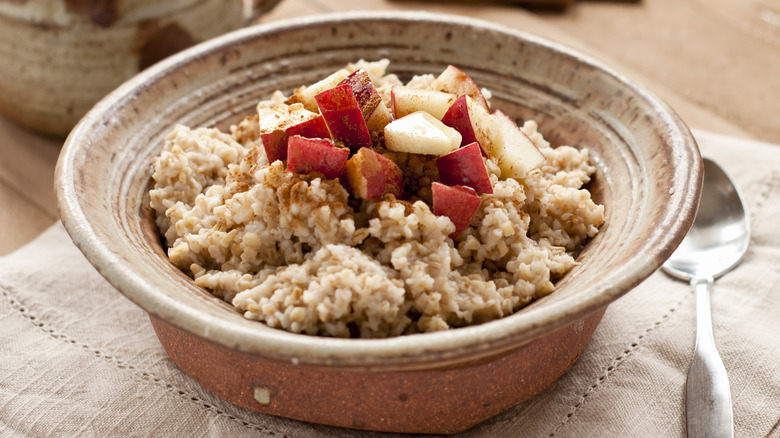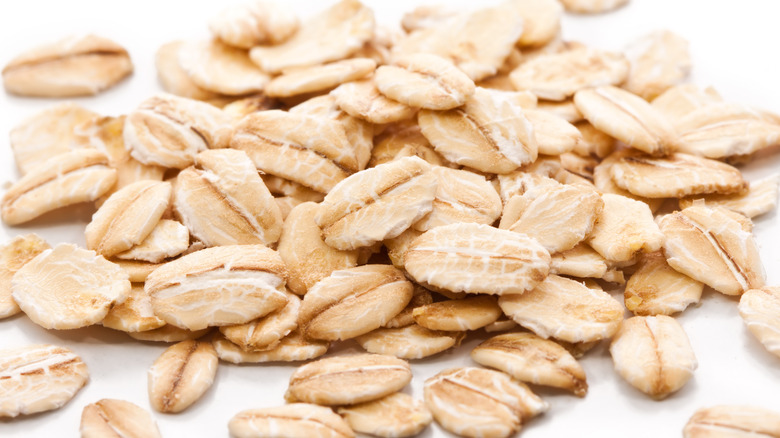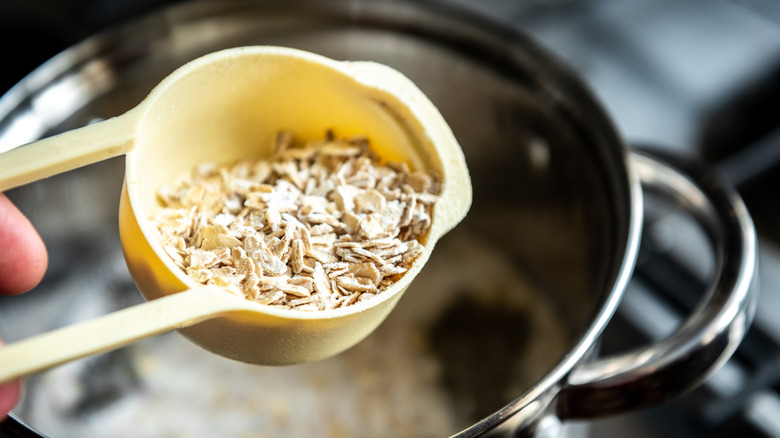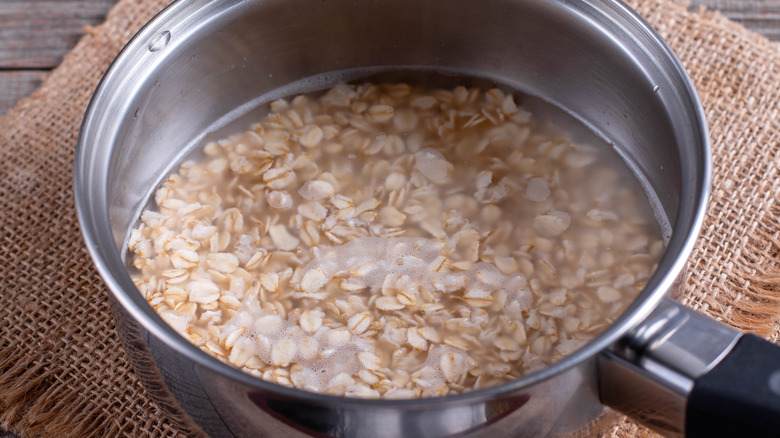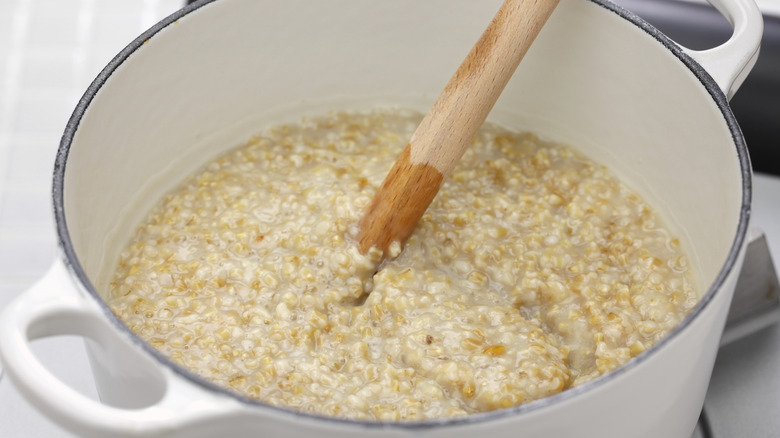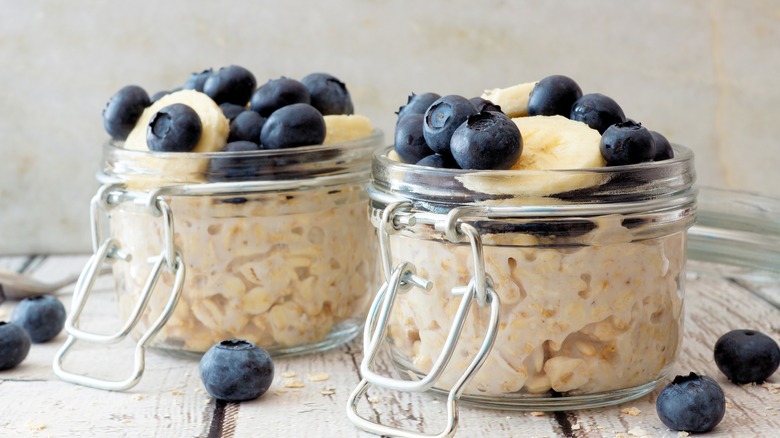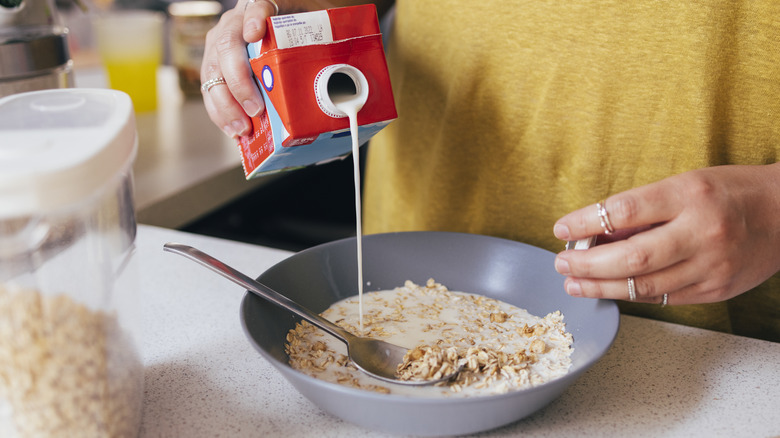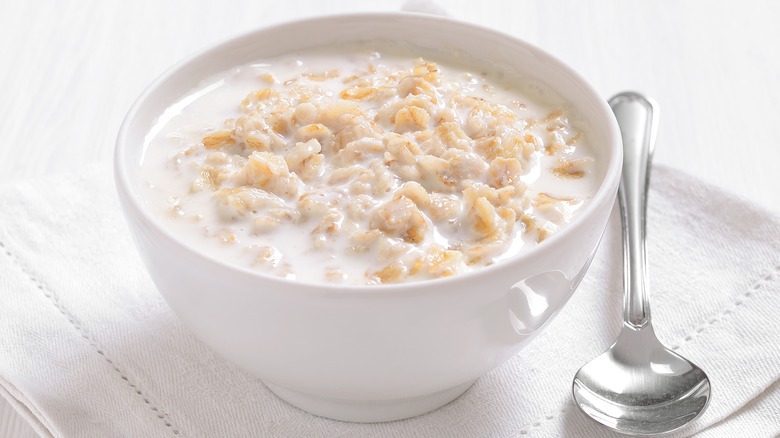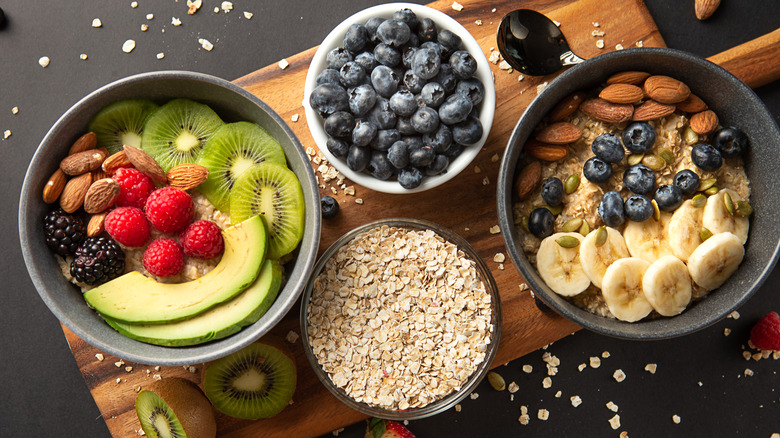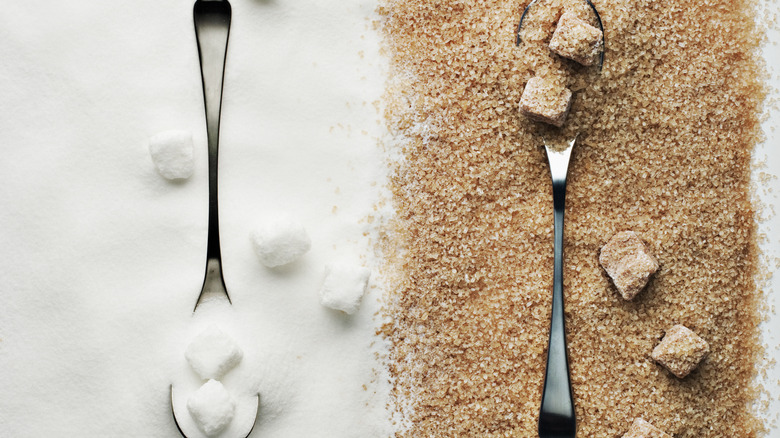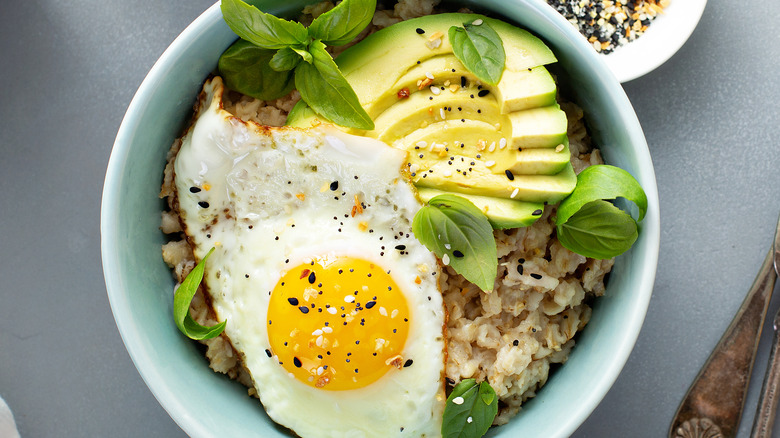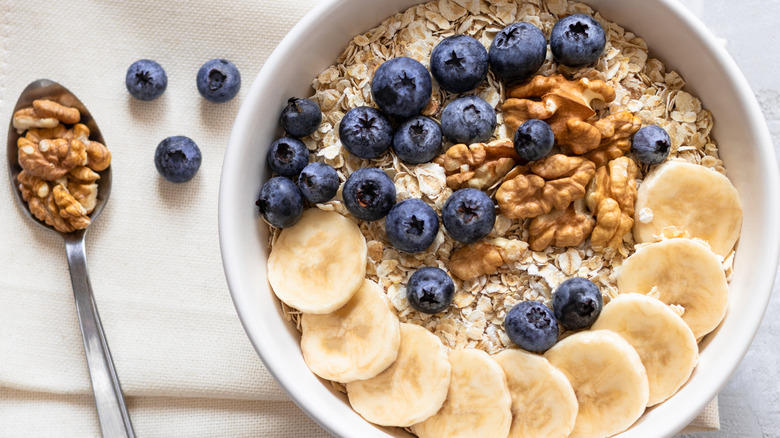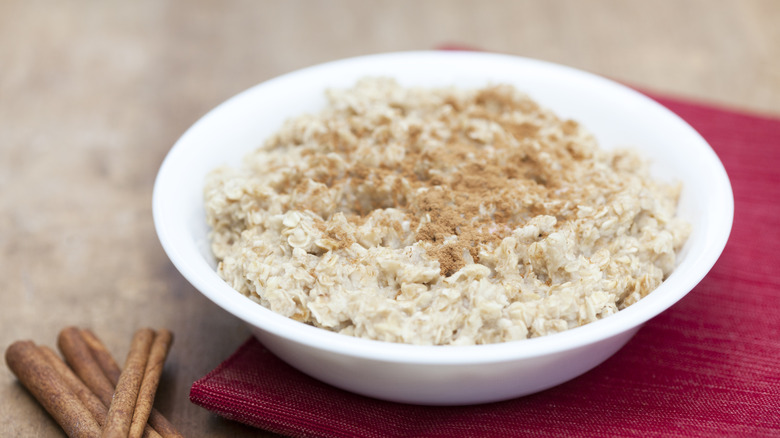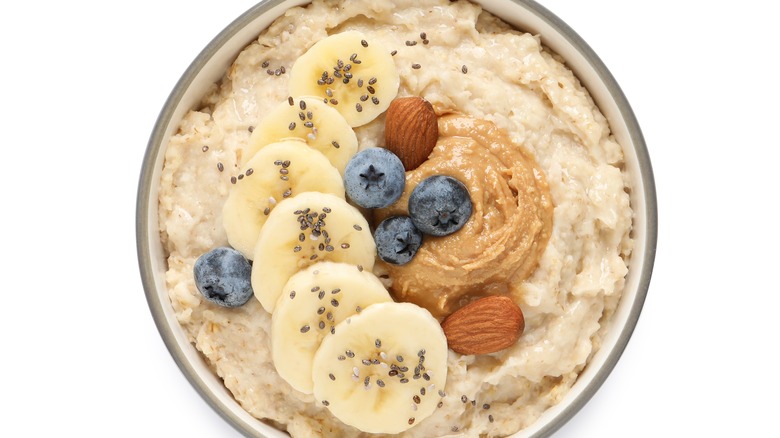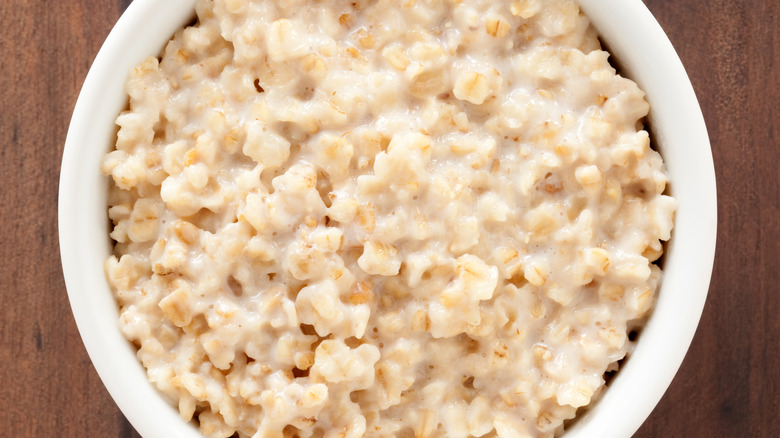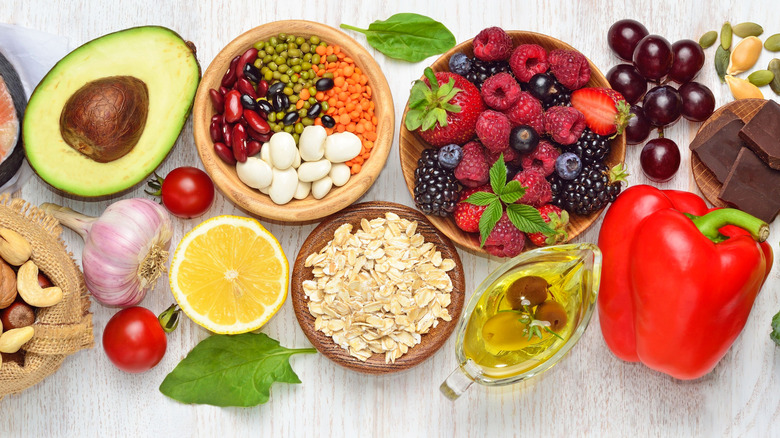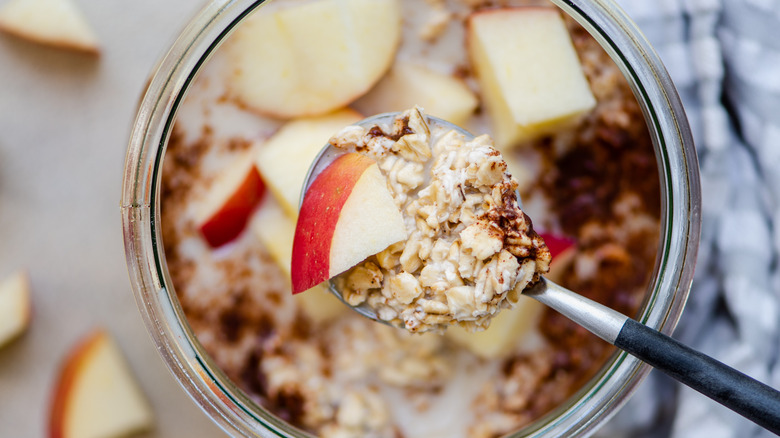16 Tips You Need To Make A Perfect Bowl Of Oatmeal
There's no breakfast food quite as hearty, nourishing, and versatile as oatmeal. The ancient cereal grain offers a plethora of health benefits, from gut health to heart health, to supplying key vitamins and nutrients including protein. Any health benefits aside, however, oatmeal is just a tasty dish that one can enjoy on a slow Saturday morning or scarf down in a Monday morning mania.
It is truly one of the most flexible breakfast options out there, serving as a blank base for hundreds of customizations. Despite being such a glorious food staple, many people tend to overlook oatmeal out of fear of mushiness and blandness. When cooked right and dressed strategically, however, oatmeal can put even the snazziest of breakfast or brunch entrees to shame.
Whether you like it sweet and fruity, or cheesy and savory, there's the perfect bowl of oatmeal out there for nearly everyone. Those who don't cook oats often may not realize the realm of possibilities when it comes to crafting a filling bowl. Some prefer to toast the oats to sweeten them up, while others pile on the superfoods; there is a whole world of grainy goodness out there, and we're here to help you craft the absolutely perfect bowl of oatmeal.
1. Choose the right oats
While all oats will have a similar flavor profile, not all oats are created equally, so it's important to figure out which type will work best for your needs and preferences. There are actually several types of oats out there, including raw oats, whole oat groats, Scottish oats, and even oat flour. For the sake of making a bowl of oatmeal, however, there are three main types you'll want to distinguish — rolled oats, steel-cut oats, and instant oats.
Instant oats are the most processed of the three, and therefore they cook very quickly — ideal for a super-quick, microwaved bowl, but not so ideal if you want the best-tasting bowl possible. Then there are rolled oats, which are also processed (and steamed and pressed, hence their flat appearance), but they're not quite as processed as the instant variety. Rolled oats may also be called old-fashioned oats, and they're perhaps the most distinguishable of all the types out there. These oats make for a tasty bowl of hot oatmeal, though they're also ideal for overnight oats as they can absorb liquid without going full mush-mode.
Finally, we have steel-cut oats, which are the least processed on this list. Because they're neither steamed nor pressed, steel-cut oats take the longest to cook, so it's best to save this variety for those slow Saturday mornings.
2. Toast the oats
Thanks to a nifty chemical process called the Maillard reaction — which is also responsible for the color of beer and the flavor of caramel — you can actually toast oats to enhance their flavor before cooking. It's as simple as adding uncooked oats (either rolled or steel-cut) to a pan over medium heat for about five minutes. You likely won't notice a significant change in color, but you'll know that the process is working thanks to the wonderful smell. When toasted, oats smell incredibly warm and rich, with just a touch of nuttiness.
Once you cook and enjoy a bowl of oatmeal with toasted oats, you'll notice a depth of flavor that untoasted oats simply don't provide. The flavor is much like that of toasted granola, and even if you don't add anything else to the oatmeal, it will taste warm, rich, and ultra-comforting.
3. Consider your cooking method
If you're looking for the absolute quickest method to cook your oats, then the microwave is the best bet. You can cook instant, rolled, or steel-cut oats in the microwave, though the latter option will take the longest. If you're working with classic rolled oats, which are the best for microwave cooking, then you'll want a 1-to-1 ratio of oats to water. Pop the oats into the microwave for an initial minute or two, then give them a stir. Microwave for another two minutes and they should be good to go — if they're still a bit soupy, microwave in one-minute increments until they're nice and thick.
While the microwave offers convenience, the stovetop is the best method for cooking oatmeal to perfection. You'll want a 2-to-1 ratio of liquid to oats here, and you'll start by bringing the water to a boil in a pot. Once boiling, add in the oats and reduce the heat, allowing the oatmeal to cook for about five minutes. Steel-cut oats may need more time, but you'll know that the oats are ready when they've absorbed nearly all of the water.
If you're really looking to get creative with cooking the oats, you can even do so in an Instant Pot or rice cooker. It's important to note that both of these methods will take longer to cook the oats, but if you have the appliances, you might as well put them to good use.
4. Enhance the flavor as the oats cook
It's easy to wait until your oats are fully cooked before adding any sweeteners, flavors, or mix-ins. While some additions are best added after the fact, it may do your bowl of oatmeal some good to receive a flavor boost during the cooking process.
You'll really only be able to add ingredients if you're cooking the oats on the stovetop, but as they're cooking, you could stir in vanilla extract, salt, sugar, or maple syrup. Not only will this process help additions like sugar or salt dissolve completely, but it will help the flavor absorb into the oats, building depth and making for an ideal base for any mix-ins or toppings.
5. Skip the cooking and try overnight oats
If you're the type who is go-go-go in the mornings, then you might not have even five minutes to spare for breakfast. No time, no problem — this sentiment is true thanks to overnight oats. Meal-preppers and cold food lovers unite over overnight oats, a method of preparing oatmeal that requires no heat.
It does require a smidge of patience, but the idea is that you'll prepare the oats the night before, so they'll be waiting for you in the fridge come morning. Rolled oats will work best here, though you could use steel-cut, they just might need more time to absorb the liquid. To prep overnight oats, you'll need a sealable jar or a small Tupperware container. The ratio of oats to liquid should be 1-to-1, and unlike with cooking oats, it's ideal to add milk right away; it will enhance the flavor and creaminess of the finished product.
Add the oats and liquid of choice to your container, and optionally add any sweeteners or perhaps a dash of salt. Then just pop the oats into the fridge and in roughly eight hours (aka a good night's sleep) you'll have tender and delicious oatmeal. Overnight oats tend to have a more pudding-like texture, and the cool, refreshing temperature pairs well with fresh berries or a good drizzle of peanut butter.
6. Be selective with your choice of liquid
It may be tempting to switch up your cooking liquid to something other than water, but due to the increased chance that your oatmeal will turn into a sticky mess, it's best to avoid cooking the oats in milk. By cooking the oats in water, you can also ensure that you'll have a neutral base for any additions you may stir in, whether that be during cooking or after the fact.
Once the oats are cooked, however, any milk additions are fair game. If you want to really hone in on that oat flavor, then oat milk is the way to go. Soy milk, depending on the flavor and/or added sweetener, will help add some creaminess (and possibly sweetness) to your bowl. Almond milk will add a subtle nuttiness (especially delicious if you opted to toast your oats), and good old dairy milk will help pack in protein and add a refreshing creamy factor. For a richer bowl, you could add in some coconut milk, and for an ultra-rich bowl, you could even drizzle in some half-and-half or heavy cream — a little bit will go a long way with that last option.
7. Find a consistency you like
If you enjoy a freshly-cooked batch of oatmeal without stirring in any liquid, it will have that thick, porridge-like consistency. If this is the consistency that you like, then you should definitely avoid any other liquid additions.
For those who enjoy their oatmeal on the looser side, however, adding liquid will naturally get your bowl to the desired consistency. How much you add really matters here: just a drizzle of milk will certainly loosen up the oatmeal, but it will still be pretty thick otherwise. If you add a larger quantity, like 1/4 cup of milk, then you'll have a soupier bowl. There's no right or wrong way to enjoy a bowl of oatmeal — spooning it or slurping it, it all comes down to finding what consistency you like best.
8. Add some superfoods
It's not always opportune to fit superfoods into our day-to-day diets, but a bowl of oatmeal offers the perfect base to pile on those superfoods, and there are quite a few to take advantage of here. Shredded coconut, blueberries, and raspberries are all additions that will amp up the nutritional value of your bowl, and other superfoods like chia seeds will hardly even affect the taste.
Not everything has to be sweet, though. If you want to take a savory superfood approach, you could even slap a fried egg or some sliced avocado onto your bowl. Either way, a quick mix into the oats should add to the flavor profile of your oatmeal as well as max out its nutritional benefit.
9. Sweeten up the oats
You can pile a whole bunch of sweet toppings onto a bowl of oatmeal, but what about the oatmeal itself? If you prefer your breakfast on the sweeter side, then there's no better option than stirring in some sugar. It doesn't have to be straight sugar, however — maple syrup, honey, agave, simple syrup, or even molasses will sweeten your bowl right up. On its own, oatmeal has a very neutral, bland flavor, so sweetening up your bowl will no doubt make it much more palatable.
If you don't want to incorporate sweetener into the oatmeal itself, you could certainly add it in the form of toppings. Fruits such as blueberries, strawberries, raspberries, and bananas all make for tasty oatmeal toppers, and they provide a natural sweetness that isn't overbearing. Looking for a topping that's even sweeter? Try sprinkling on some chocolate chips for a treat-like addition.
10. Take a savory approach
Sweet bowls of oatmeal tend to win the popularity contest, but savory bowls definitely have their place in the breakfast world. Instead of mixing sugar into your bowl of oatmeal, you could keep the base neutral and top off the bowl with savory delights as we mentioned earlier: fried eggs, avocado slices, sesame seeds, or shredded cheese. Once you break the savory seal and realize that oats can go with anything, your imagination can run wild.
If you like the idea of adding an egg to a bowl of oats, why not take things a step further and add an egg directly into the oats? You'll have to make the addition as your oats are cooking, but believe it or not, this unexpected ingredient will absolutely enhance your oatmeal, both texture-wise and nutrition-wise.
11. Add some textural elements
Oatmeal is a notoriously mushy food, but there are ways to liven up even the mushiest of bowls with more texturally interesting foods. If you're a fan of nuts, then just about any type pairs well with a bowl of oatmeal — cashews, walnuts, pecans, and almonds are all good options to help crunch things up.
If you aren't a fan of nuts or have an allergy restriction, fear not, as there are plenty of other crunchy options out there. Though granola is basically just oatmeal in a different form, it will definitely elevate the texture of your bowl. Pumpkin seeds will add a light crunch, and even dried fruits like cranberries, dehydrated strawberries, or banana chips will add some contrast.
12. Spice things up
Adding flavor to your bowl of oatmeal is often synonymous with adding sugar, but that certainly doesn't have to be the case. There are plenty of spices that will give your bowl a flavorful, warm touch without upping the sugar content, such as cinnamon, nutmeg, cardamom, or allspice. And, if you can't decide on any one spice, you could add a dash of pumpkin pie spice to cover all of those warming notes while making your bowl taste like a fall-favorite dessert all in one swoop.
Another perk about adding spices is that they will add some complexity to the oatmeal. Even just a dash of cinnamon will add a warm, woody undertone to your bowl of oatmeal, so even if you eat it with nothing else, it'll taste much better than its completely unseasoned brethren.
13. Dollop on some sauce, yogurt, or puree
There are few foods that a good dollop of sauce can't improve, and oatmeal is no exception. The definition of sauce can be pretty liberal here — anything from nut butter, yogurt, jam, hot sauce, and purees can count as a sauce. Not only will these additions bulk up the calorie and nutrition content of your oatmeal, but they'll add textural contrast and maybe even some creaminess, depending on the addition.
One of the best dollops for a bowl of oatmeal happens to be pumpkin puree. The canned ingredient will change your bowl of oatmeal for the better, adding a subtle earthy flavor and lots of nutrients, including fiber. Add a spoonful of pumpkin puree and a dash of pumpkin pie spice and voila, you've got an autumnal bowl that will warm you right up no matter the season.
14. Incorporate some nourishing fats
Being the neutral vessel that it is, a bowl of oatmeal provides a great opportunity to get some healthy fats into your diet. A simple drizzle of olive oil or a teaspoon full of butter or ghee will add both fattiness and richness to your bowl, and they'll mix right in with ease.
If you don't want to take the mix-in approach, however, then there are plenty of toppings that will do the trick. Avocado, eggs, nuts, and chia seeds are great toppers that will enhance your bowl to leave you feeling full and satisfied. We also know what those ingredients can do for both the flavor and nutritional profiles of your oatmeal, too, so consider those factors as an added bonus.
15. Don't overdo it with the mix-ins and toppings
With the vast amount of foods that you can add to oatmeal, it can be quite easy to overdo it. Sure, it's a good idea to experiment and get creative when crafting your ideal bowl. That said, less can be more, especially when oatmeal is a hearty base all on its own.
When putting together a bowl of oatmeal, only add toppings or mix-ins that complement one another. For example, almonds, peanut butter, and granola would all pair well on top of a bowl of toasted oats, and the warm, nutty flavors will play well together. On the other hand, eggs, avocado, and a drizzle of hot sauce would all work well in a savory bowl, seeing as the fatty foods would benefit from a hit of spice.
Separately, those bowls would taste great, but if you were to combine the ingredients of both bowls into one, it would be a nightmare. Stick with a theme when constructing your bowl, and as tempting as it may be, don't pile on too many toppings.
16. Enjoy the oats hot or cold
Much like there's no one superior topping for oatmeal, there's also no right or wrong temperature to enjoy your bowl. While it is most common to enjoy oatmeal freshly cooked and hot, cold oatmeal is also refreshing and just as palatable. If you prefer cold oatmeal but just made a batch, let it cool down in the fridge before digging it. Alternatively, if you made a batch of overnight oats but typically enjoy them hot, there's nothing stopping you from warming up a batch of overnight oatmeal.
The true key to enjoying the perfect bowl of oatmeal is finding a combination of temperature, milk, texture, sweetness, mix-ins, spices, and toppings that best suits your preferences. Whether you're an oatmeal purist who enjoys a plain and simple bowl or you're an oatmeal creative who is constantly experimenting with new toppings, there are plenty of oats to go around and endless ways to enjoy them.
